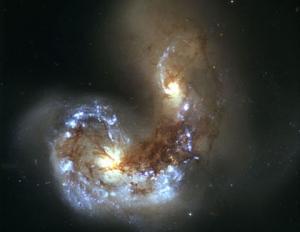The galaxy proto-cluster, named LBG-2377, is giving scientists an unprecedented look at galaxy formation and how the universe has evolved. Before this discovery, the farthest known event like this was approximately 9 billion light years away.

|
| ©University of California - Irvine |
| Two galaxies interacting. |
"When you observe objects this far away, you are actually seeing the universe as it was a very long time ago," said Jeff Cooke, a McCue Postdoctoral Fellow in physics and astronomy at UCI and lead author of this study. "It is as if a timeline is just sitting out there in front of you. These galaxies represent what the universe looked like well before the Earth existed."
Using the Keck Telescope in Hawaii, Cooke detected LBG-2377 while looking for single galaxies. At first, it appeared to be a bright, single object. But after analyzing the wavelengths of its light (galaxies emit light with telltale colors) he discovered it was three galaxies merging together, and likely two additional smaller galaxies.
Scientists use light to look back in time. Because light takes a measurable amount of time to travel, detecting it on Earth today allows scientists to view the source as it was billions of years ago. In the case of LBG-2377, scientists believe the light has been traveling for 11.4 billion years, beginning just a few billion years after the Big Bang when the universe was only 15 percent of its current age. By comparison, the Earth was formed about 4.5 billion years ago.
The process of galaxy formation largely is a mystery. Current theory is that large galaxies formed over time from the interaction and merging of smaller galaxies. This process began more than 12 billion years ago, shortly after the Big Bang. Scientists have observed galaxies merging over a large range of distances and time, providing hard evidence to reinforce the theory. However, using current technology, it is difficult to detect this process at the most extreme distances, when galaxy formation was in its infancy.
Scientists believe galaxy clusters form in a similar manner. As galaxies congregate and interact in large, dense regions of space, the cluster grows with time. Witnessing this process first-hand helps scientists confirm their theory and deepen their understanding of the universe. Galaxy clusters can be detected at extreme distances with current technology because they are bright, but they are difficult to find.
Clusters closer to Earth contain upwards of 1,000 galaxies. Our Milky Way galaxy belongs to a lesser grouping of galaxies called the Local Group, which contains more than 35 galaxies, but only a few bright ones.
"We believe LBG-2377 is a seed that eventually will grow into a massive galaxy cluster," said James Bullock, director of the Center for Cosmology at UCI and a study co-author.
"Our finding suggests that this is a monster structure being born in a very bright, catastrophic event with a lot of gas and matter collapsing at once," Bullock said. "We are not just seeing one solitary galaxy. We are seeing a bunch of bright galaxies coming together at the dawn of structure formation in the universe."
This research is reported in the online bulletin astro-ph. Scientists Elizabeth Barton and Kyle Stewart of UCI, along with Arthur Wolfe of the University of California, San Diego, worked on this study. The research was funded by a Gary McCue Postdoctoral Fellowship and the National Science Foundation.
Adapted from materials provided by University of California - Irvine.



Reader Comments
to our Newsletter